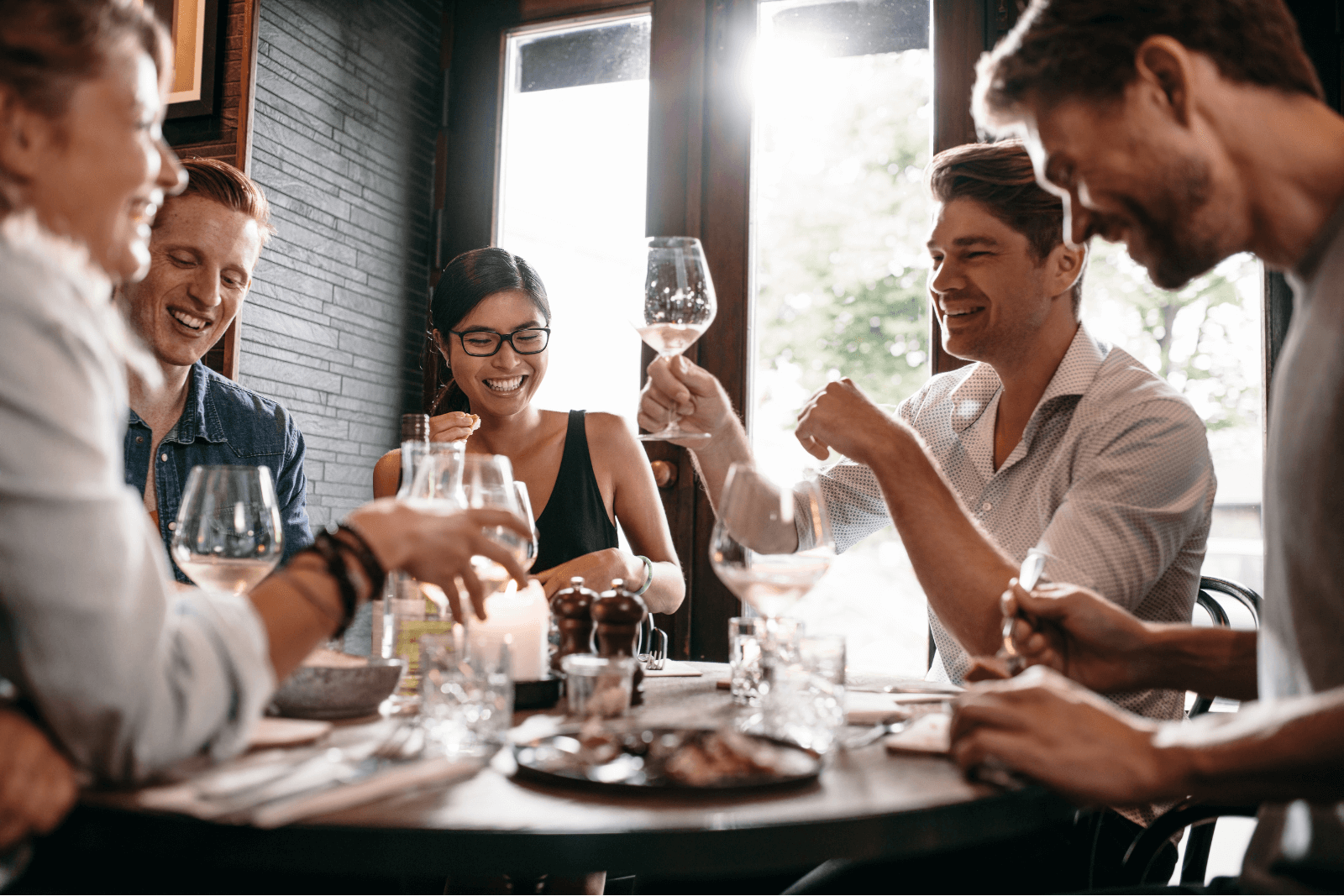Have you ever found yourself dealing with a customer who claims to have made a reservation two weeks ago via phone, but there's no record of it, and your restaurant is fully booked with no available space for them?
Undoubtedly, it's an uncomfortable and frustrating moment for both parties involved.
On the other hand, perhaps you've experienced a scenario where you had a reservation for four guests only to have none of them show up.
You were left in the lurch without any prior notification, and it was too late to offer the vacant table to someone else.
Frankly, it's challenging to determine which of these situations is worse.
And these are just a couple of the many common reservation challenges that restaurant owners face.
In this article, we will delve into six such hurdles and, most importantly, provide effective solutions to overcome them and transform your reservation process into a seamless and stress-free experience.
Let's dive right in!
Mistakes When Taking Reservations by Hand
Manually managing reservations in a bustling restaurant presents numerous challenges.
Amidst the dynamic and busy atmosphere, with waiters rushing to and from the kitchen, guests eagerly waiting to be seated, and chefs hurrying to prepare dishes, the staff must also attend to phone calls and emails for reservations.
In such a hectic and noisy environment, mistakes are bound to occur—from noting down the wrong date or hour to missing reservations entirely.
The consequences of these errors can be frustrating for both the guests and the restaurant.
For instance, let's take the case of this dissatisfied TripAdvisor reviewer who made a reservation and arrived on time, only to find the restaurant ill-prepared due to a potential mishap in the manual recording of the reservation.

Source: TripAdvisor
As a result, the staff had to scramble to find suitable seating and make impromptu table changes, creating an unpleasant experience that could potentially lead to losing these valuable guests.
However, there is a solution to this predicament—investing in a restaurant reservation system that handles reservations automatically and spares you from these mishaps.
Consider a reliable online reservation software like our Tablein, which seamlessly manages reservations online, freeing up your team to focus on other essential duties.
With this software, your guests can conveniently make reservations online and select their preferred date and time to dine without being confined to your restaurant's working hours, as Tablein operates 24/7.
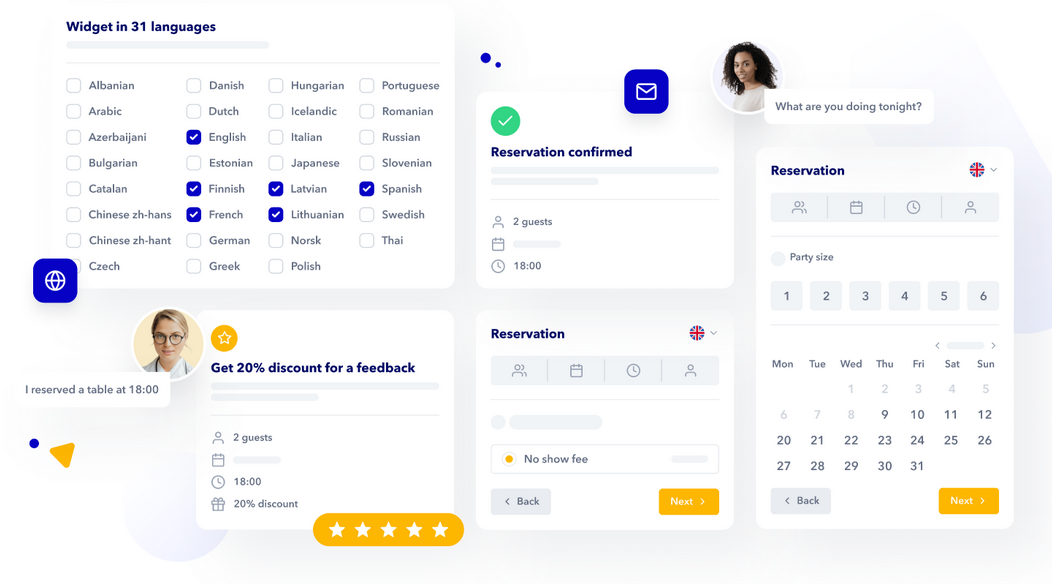
Source: Tablein
Moreover, the risk of errors, like lost reservations or incorrect dates and times, is significantly reduced, as all the information is promptly confirmed to your guests through automated confirmation emails.
On the operational side, you and your staff will have access to a centralized system where all reservation details are clear, visible, and organized, making it easier to accommodate more reservations efficiently.
In conclusion, by embracing restaurant reservation software, you can bid farewell to the troubles of manual reservation handling and ensure a seamless and pleasant dining experience for your patrons.
Chance of Overbooking
Overbooking is another significant challenge of handling reservations manually.
When multiple staff members handle reservations without a centralized system, they lack a comprehensive overview of the existing bookings.
As a result, accidental overbooking or double-booking of tables becomes more likely.
Such situations are highly distressing for would-be diners who arrive with confirmed reservations but find no available tables.
Consequently, they may express their frustration through negative reviews, potentially tarnishing your restaurant's reputation—and often rightfully so, as you can see from the unsatisfied guest below.
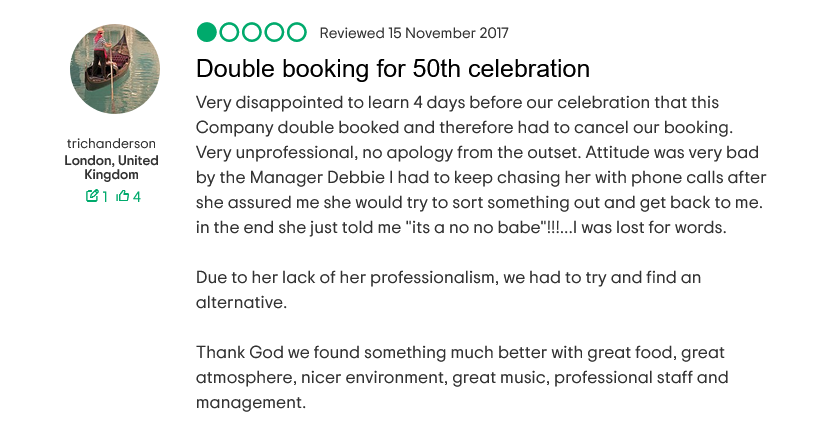
Source: TripAdvisor
To address this challenge, you should first understand your restaurant's capacity and avoid accepting reservations beyond the available space.
Additionally, you have to keep track of which tables are already taken, as this will prevent double-booking troubles.
However, doing this manually would be very challenging and time-consuming.
Fortunately, the perfect solution lies in adopting an appropriate online reservation software with features for setting up floor plans and specifying the maximum number of guests per table.
With such software, you can view your current floor plan and instantly identify booked tables, tables reserved for walk-ins, and those still available.
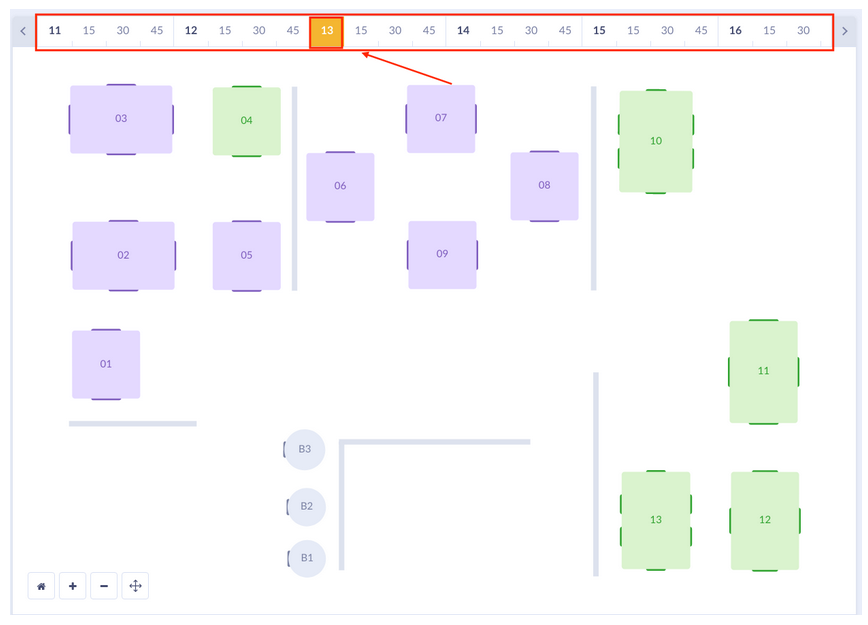
Source: Tablein
Furthermore, employing color-coded labels, such as gray for available tables, blue or green for booked tables, and violet for walk-ins, can give you an even more precise overview of table availability.
In short, if you know your booking capacity and utilize software that shows a clear overview of all your tables in front of you at all times, you can ensure smooth reservations without incidents like overbooking or double-booking.
Moreover, this is also a way to safeguard your restaurant's reputation from unfavorable reviews caused by overbooking mishaps.
Poor Reservation Management
Despite the undeniable benefits of accepting reservations, poor reservation management can lead to frustrating customer experiences.
One common issue is booking guests too closely together, leaving inadequate time for them to finish their meals.
This results in rushed service or you asking guests to hurry or relocate, so you can accommodate new patrons, creating an uncomfortable atmosphere for everyone involved.
On the other hand, even though they’ve arrived on time, new guests may find their tables unprepared, leading to frustrating wait times.
Both situations can understandably breed negative sentiments among your guests and ultimately affect their overall dining experience.
Let’s see what you can do to avoid this altogether.
First, consider the average dining time at your restaurant and use this information to space out reservations more effectively.
You should closely monitor dine-time metrics to calculate the average dining time, as this upscale casual restaurant, Wagshal’s, did:
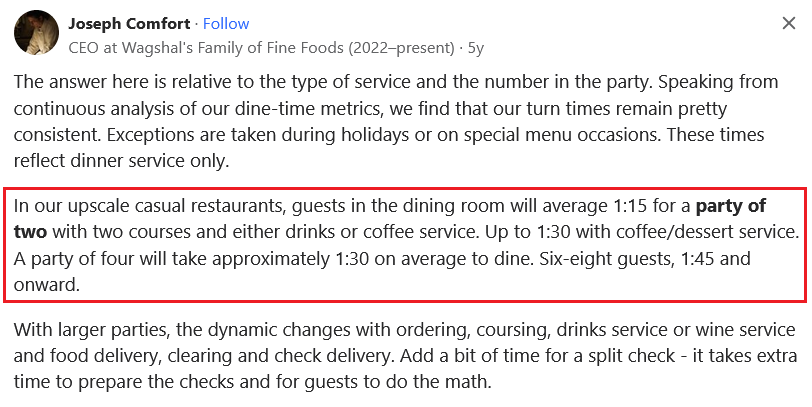
Source: Quora
Moreover, you can implement upfront limits on table reservations, as this can significantly improve reservation management.
You should inform your guests of the time when you require the table back in your reservation policy or just before they make a reservation.
The Swansea-based restaurant Dark Horse Mumbles does this in their booking widget:
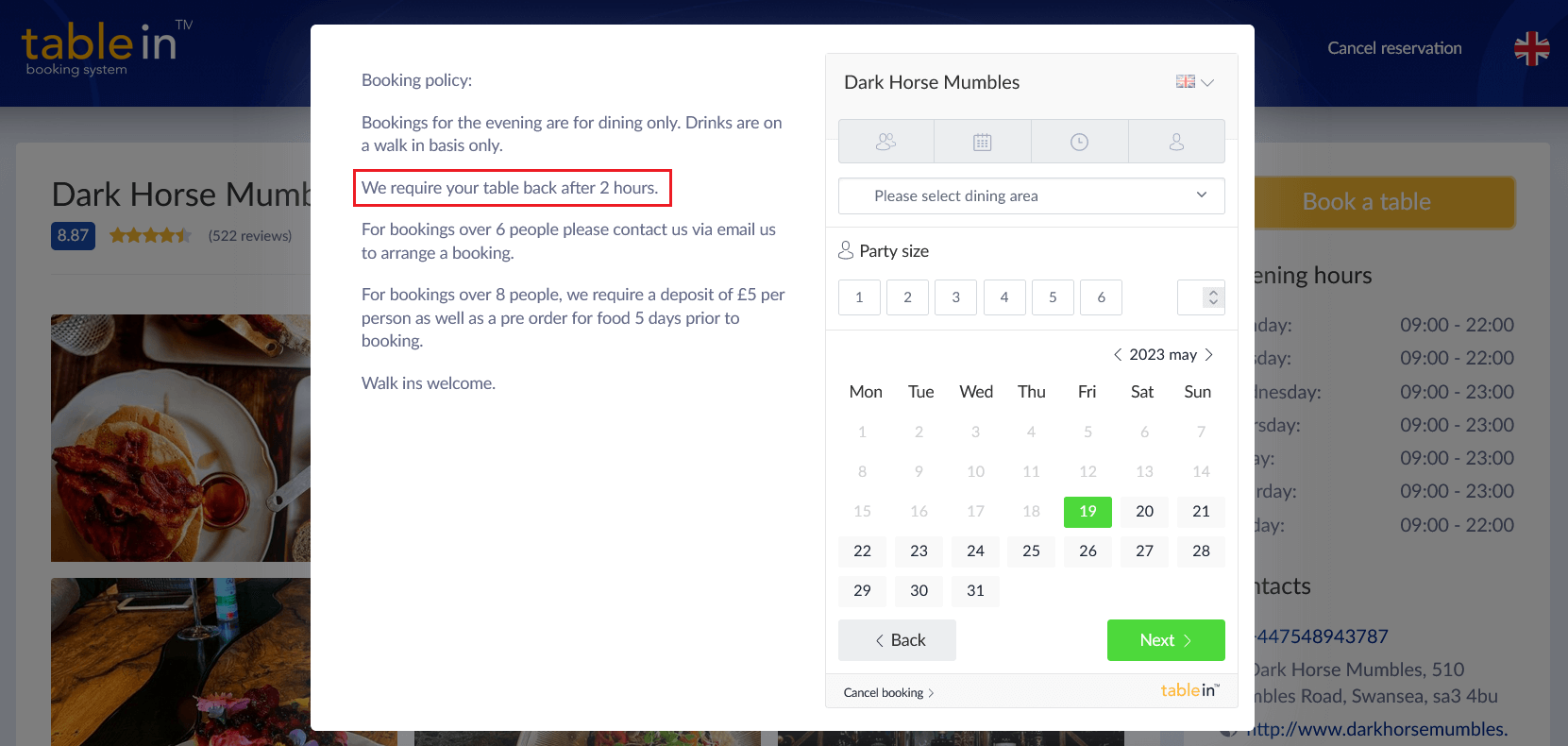
Source: Dark Horse Mumbles
With this transparent approach to taking reservations, guests have the necessary information to decide if the allocated time, in their case two hours, suits their dining preferences.
This empowers prospective diners to make informed decisions before making reservations, leading to a smoother and more satisfactory dining experience.
In summary, addressing the challenges of poor reservation management involves spacing out reservations wisely based on average dining times and providing clear information to guests upfront regarding table reservation limits.
By doing so, you ensure your tables are always occupied, but no one is rushing, and not a single patron leaves your restaurant unhappy and dissatisfied.
Inefficient Communication With Customers
Inefficient communication with customers is the fourth common challenge of taking reservations that we’ll address today.
When your customers book a table online or via email, they expect you to reply promptly and confirm their reservations.
And when your staff must take time out of their busy day to manually send out reservation confirmations and such emails, it leads to wasteful and unproductive use of their time.
Not to mention all those phone calls to remind prospective guests of their reservations a day or two before they’re set to arrive!
To alleviate this burden, automated communication with the guests becomes essential.
But instead of hiring a dedicated staff member solely for this time-consuming task, the right online reservation software can efficiently handle communication with guests and make it a breeze.
The system can automatically send confirmation emails to patrons upon booking a table.
Such emails provide all necessary details, like the date, time, number of guests, contact information, and instructions to cancel if their plans change.
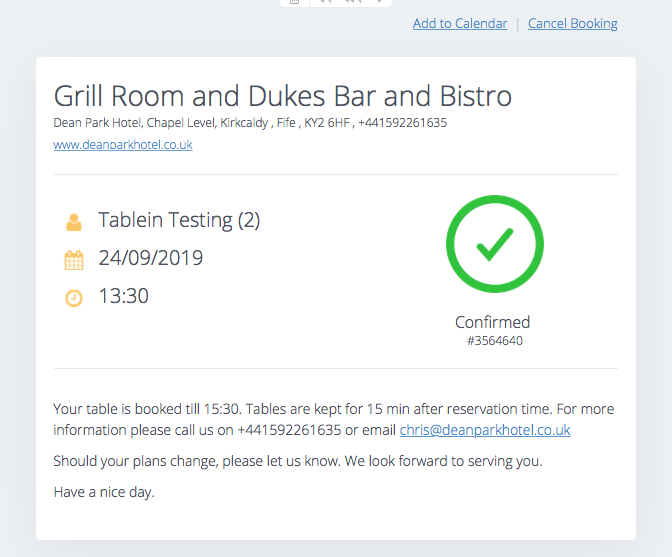
Source: Tablein
Moreover, online reservation software can help prevent guests from forgetting their reservations and potentially not showing up.
The software can send re-confirmation emails a day or two before the reservation, prompting guests to manually confirm their booking.
With this proactive approach, there is no way your guests will forget and not honor their reservations.
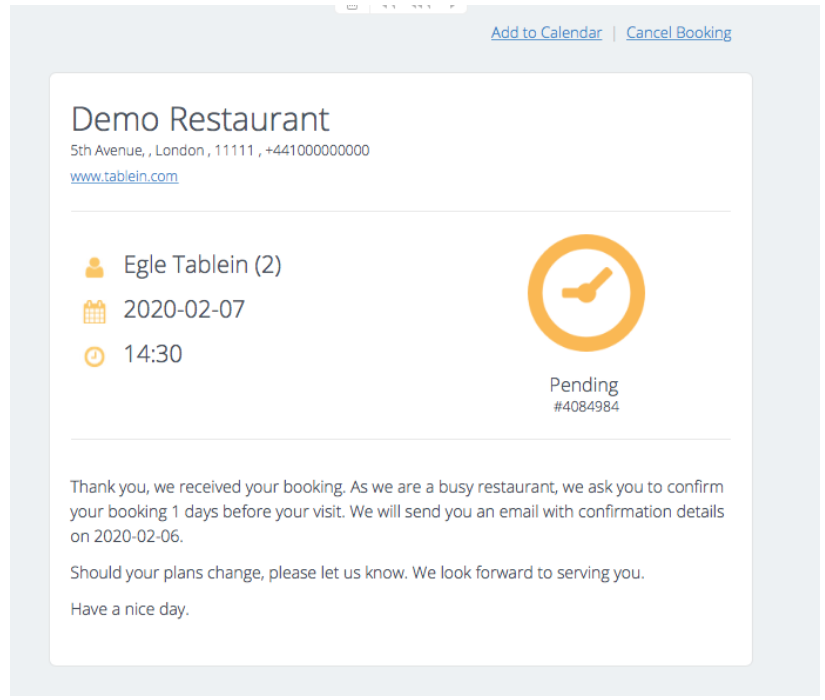
Source: Tablein
In essence, the right software will streamline communication with patrons throughout the entire reservation process, from sending confirmation emails to booking reminders and re-confirmation emails.
You and your team won’t have to do it manually anymore, giving you more time to focus on other aspects like enhancing customer service and providing the best dining experience to your patrons.
Prevalence of No-Shows
When you choose to accept table reservations instead of relying solely on walk-ins, you expose yourselves to the risk of no-shows.
No-shows are prospective patrons who make reservations but fail to turn up without any prior notification, leaving restaurants with empty seats and lost revenue.
The survey done by Carbon Free Dining showed that there are several reasons behind this phenomenon.
Some would-be diners admit they forget, some simply don't bother to cancel, and others struggle to find their booking details.
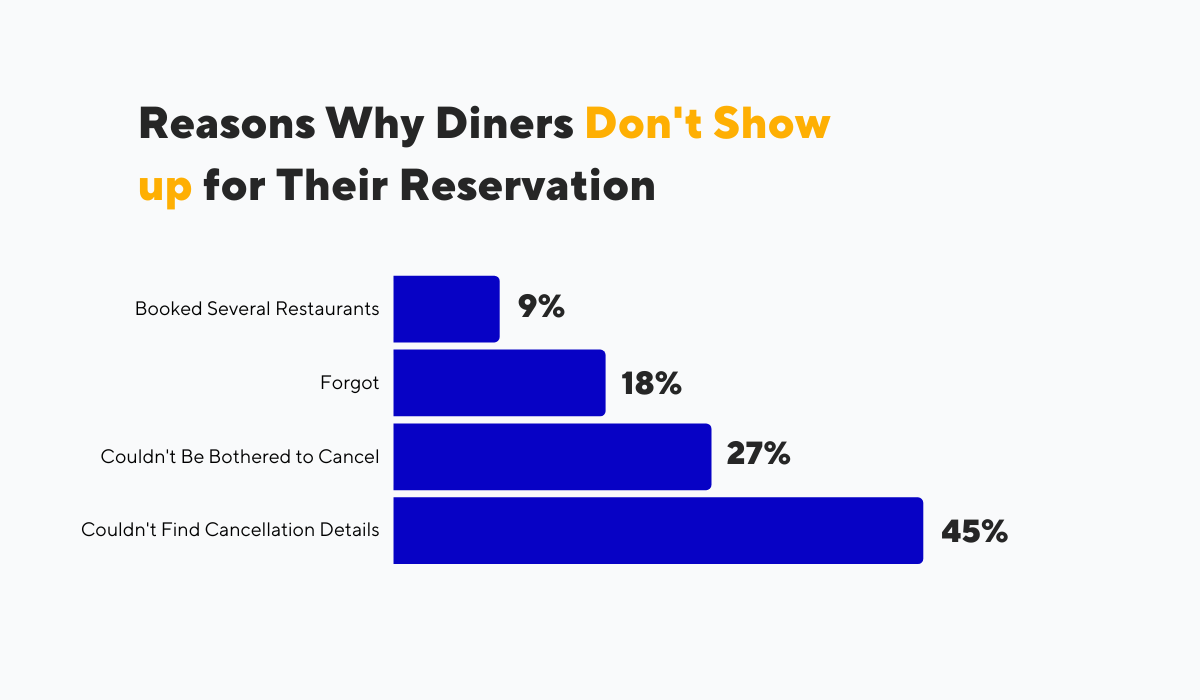
Illustration: Tablein / Data: Carbon Free Dining
Whatever the reason might be, no-shows are a common and, unfortunately, costly problem for many restaurants.
But while it may be challenging to completely eradicate this problem, there are effective solutions to reduce its impact.
One approach we’ve already mentioned when we talked about automated communication—sending an email asking your guests to re-confirm their booking a day or two before the reservation.
This gentle nudge serves as a helpful prompt, ensuring that their reservation remains fresh in their minds so they don't forget it.
Another efficient way to reduce no-shows involves financial incentives, making your guests more cautious about honoring their arrangements.
For instance, you can take pre-payments or deposits when guests make reservations.
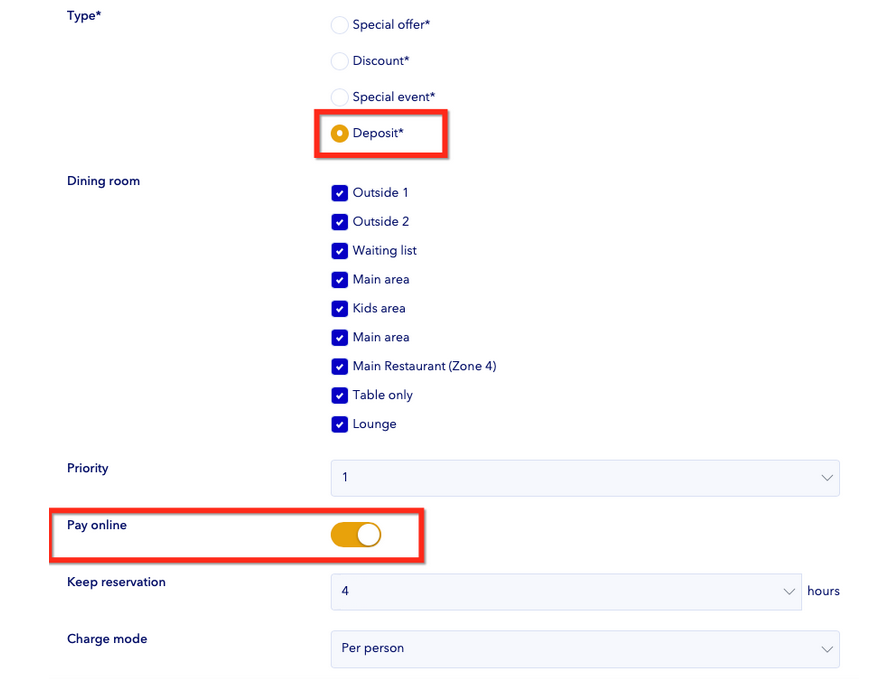
Source: Tablein
This immediate financial involvement instills a sense of responsibility in them, prompting them to be more cautious about canceling on time or not showing up.
Alternatively, if upfront charges don't align with your restaurant's policies, instituting late cancellation or no-show fees can also protect your business from significant losses.
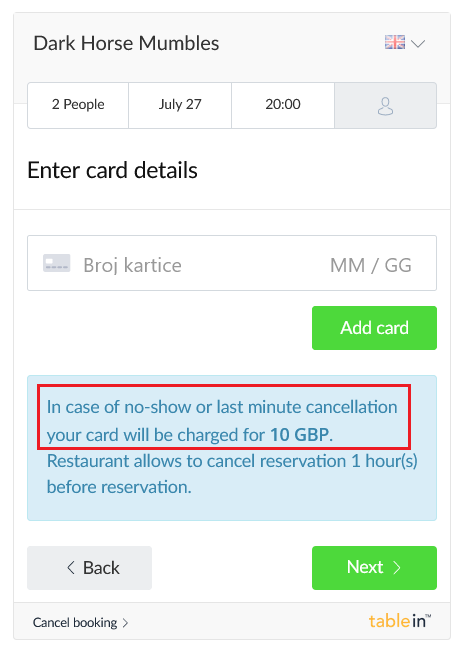
Source: Dark Horse Mumbles
In summary, whether it's taking deposits, prepaid reservations, or late cancellation and no-show fees, with reliable reservation software, you can easily set up and manage these features when processing reservations.
This can help you greatly to keep your profits steady despite the occasional no-shows.
Losing Walk-in Customers
One of the key challenges, and the last one we will address today, that restaurants face when adopting table reservations is the potential loss of walk-in customers.
While reservations offer predictability and organization, they can inadvertently lead to turning away spontaneous diners due to a lack of available tables.
Not everyone likes to plan their meals ahead, and that's completely all right too.
Some people prefer to walk into a restaurant and, if available, great—if not, they are willing to wait a little bit, as nicely put down by this Reddit user:

Source: Reddit
So, to avoid losing walk-ins, it's essential to strike a balance between taking reservations and accepting walk-in guests.
The first crucial step is to allocate a designated number of tables exclusively for walk-ins.
By doing so, you guarantee that even during peak reservation times, there will still be ample space for those who prefer to decide on the spot.
Additionally, implementing a waiting list system can be a game-changer in retaining walk-ins.
Here's how it works—when all tables are occupied, and someone walks in asking for a table, you can invite them to join your waitlist instead of dismissing them, as happened in this Parisian restaurant:

Source: Reddit
Instead of saying "no" like the host mentioned above did, you should collect the walk-in's contact details—most importantly, their name and phone number.
You can suggest they explore nearby coffee shops or bars while they wait, and in the meantime, you will put them on your waiting list.
Here your reservation software swoops in again and automates the rest for you.
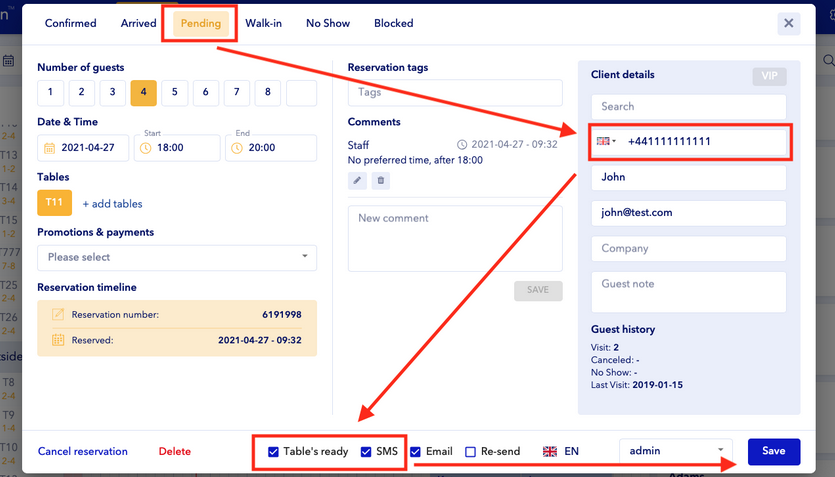
Source: Tablein
Once a table becomes available and you enter that information in the system, the software will send an SMS notification to those on the waiting list, letting them know it's their time to savor a delightful dining experience.
To conclude, your restaurant can maximize occupancy by skillfully balancing reservations and walk-ins while ensuring every guest feels valued and welcomed, be it the one who made a reservation or the one who walked in spontaneously.
Conclusion
While taking reservations offers numerous benefits for your restaurant, it also comes with challenges.
Today we discussed six of them—manual reservation errors, overbooking and double booking, inefficient communication, no-shows, poor reservation management, and potential loss of walk-in customers—and gave you practical solutions for each.
In conclusion, adopting the right online reservation software will help you efficiently manage all your reservations and overcome all these challenges.
As a result, your staff will be more productive, and your patrons will be happy and satisfied.
Get a 30-day Exclusive Trial
As a Tablein blog reader, you’re eligible for an exclusive 30-day free trial to experience our simple reservation solution for your restaurant.
Enter your business email, and we’ll send you all the steps needed to create your account.
Share this
You may also like

How to Manage Last-Minute Restaurant Reservation Cancellations
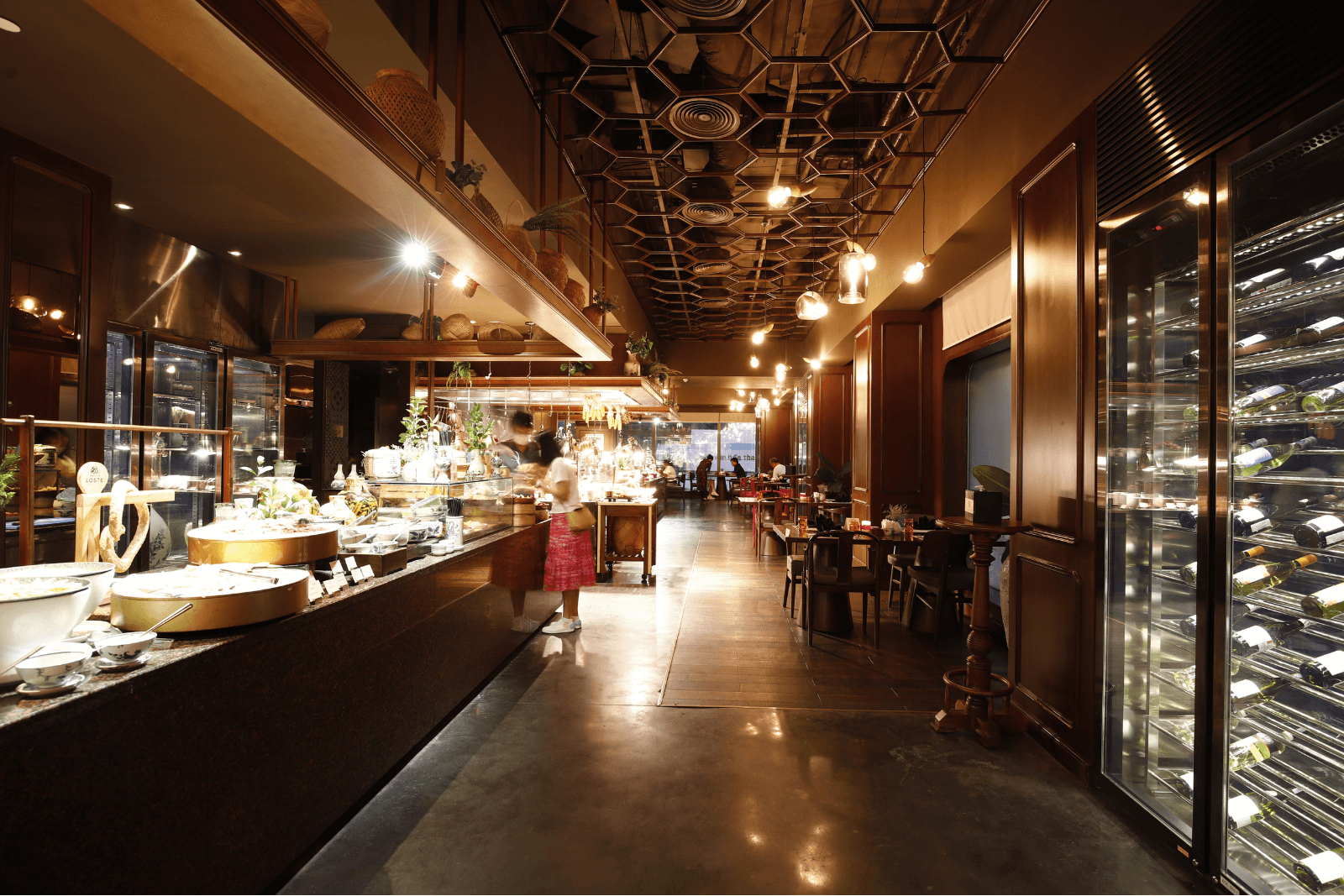
Top Restaurant Management Challenges (and Solutions)
